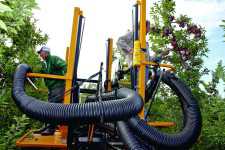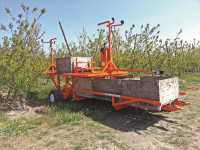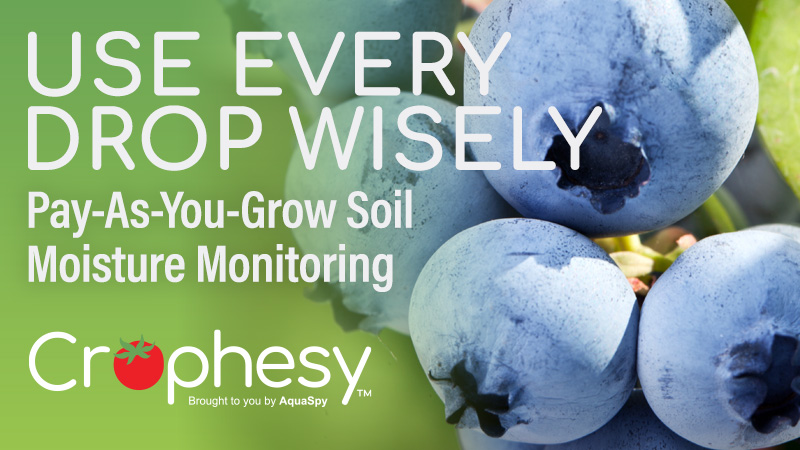The Future Is Now For Orchard Technology

Perhaps the best way to sum up the remarkable progress that’s been made in apple harvesting technology comes from Karen Lewis, a regional tree fruit specialist at Washington State University Extension. Lewis notes that just a couple years ago, at the Washington State Horticultural Association’s annual meeting, there was not one harvest machine on the trade show floor. “This past year, there were four of them,” she says. “We’ve come a long way.”
This is true not just in Washington, but in other major apple-producing regions as well. Led by collaborations between growers, universities, and private companies (along with helpful federal funding on occasion), tree fruit leaders across the country are putting all their efforts into developing technology that is designed to improve efficiency and, more important, attract labor, on the farm. Here’s a look at what’s happening in some of these areas, and what growers can expect to see in the near future.
DBR: More Trials Ahead
The talk of Michigan apple growers the past couple years has been the vacuum assist harvesting unit developed by DBR Conveyor Concepts of Conklin, MI. The group recently submitted a project proposal to the Michigan Apple Committee that would involve making a number of improvements to the machine, including changing the configuration of the decelerator and bin filler so their speeds can be controlled independently; making improvements within the decelerator to further eliminate bruising; installing better actuators for the bin filler so it could be filled more evenly; and installing LED lights for night-time picking.
This year, DBR is planning an in-depth full-season commercial trial of the system. Riveridge Produce Company and Riveridge Packing LLC will serve as the commercial test orchard and packinghouse. Various large apple blocks of different varieties, densities, training systems, ages, and tree types will be available for side-by-side comparison with conventional picking. Detailed labor and payroll records will allow for easy collection and summary of costs analysis, labor efficiencies, and per-unit breakout of harvester performance.
Michigan State University personnel led by district horticulturist Phil Schwallier will provide record keeping, summary, and analysis of operations, pictures, block descriptions, and final reporting. RFID or a scanned tagging system to track bin location will be used to gain accuracy of data.
According to DBR, their objectives including the following:
- Measure the efficiency of the apple vacuum harvester machine (time, bruising, economics, costs, labor, etc.) on numerous blocks
- Measure the efficiency of the machine under various harvest methods and conditions (color and strip picking, picking only tree tops, stem clipping picking, and picking at night with lights or shade canopies)
- Measure fruit quality, fruit storage quality, and fruit shelf quality in comparison to side-by-side conventional harvest.
- Get a handle on parameters for different vacuum/velocity settings for different sizes and varieties of apples to be picked. Also, get settings for the bin filler distributor to adjust speeds accordingly.
- Realize importance of a properly trained crew on both platforms and harvester.
“This new technology is now available to the fruit industry, yet on a large-scale commercial basis has not been evaluated,” says Mike Rasch, one of the partners in DBR. “This is an opportunity to capture significant information on its performance. The fruit industry will gain significant early access to our evaluation and potential early adoption by the Michigan apple industry. The potential labor saving from this machine is now a critical issue for the apple industry with labor shortages expected in the future.”
If You Build It …
At Penn State University, Paul Heinemann in the Department of Agricultural and Biological Engineering says they have been able to get some support for continuing a harvest-assist project from the State Horticultural Association of Pennsylvania and the Pennsylvania Department of Agriculture. Tests on the DBR unit were performed in the fall of 2012, primarily led by Jim Schupp at Penn State’s Fruit Research and Extension Center. “We evaluated the mechanical characteristics of the DBR prototype, but primarily with the goal of how we could adapt some of their approaches to a smaller, less complicated unit,” says Heinemann. “With the purchase of a battery-
powered platform unit, we are now developing a low-cost harvest assist device that would mount directly on a “chariot” and would feed apples to the bin using gravity, but with minimum bruise potential.” Heinemann notes they are in the design phase right now and hope to do lab testing this summer, then field testing in the fall.
“Like most of the modern orchard equipment being designed and tested, this would be most useful in flatter, two-dimensional orchard systems,” says Heinemann.
“Growers need to understand that we will be able to greatly improve mechanization if the orchards are structured to better fit the optimal machinery design rather than the other way around.”
Schupp echoes Heinemann’s sentiments. “The horticulture needs to be adapted to the mechanization, creating narrow tree walls,” he says. “The good news is that the best orchard designs for adopting mechanization are also great for increasing marketable yield of high-quality fruit, and for simplifying orchard tasks. Build it (the modern orchard) and they (the engineers) will come.
From The Ground Up

In Washington, Lewis says her team partnered with the University of Washington on an ergonomics study, and also evaluated efficiency and bruising. “In our Granny Smith trials (which bruises very easily), when we ran it across a commercial line, the grower was quite pleased with the results and the packouts.” The ergonomic study involved putting sensors on the workers to measure heart rate, joint bending, and fatigue compared against using a ladder. The data from the study is still being evaluated, and will include best management practices. “At the end of the day, you will attract a greater workforce if you can put them on a platform than if you give them a ladder and a bag,” says Lewis.
“Platform picking machines have to be a part of our future,” says Lewis, who notes the rapid progress being made by several companies in the Pacific Northwest in coming up with machines with varying levels of sophistication. While the DBR and similar models are based primarily on vacuum tubing, other companies are focusing more on combining movable bins with platforms. “Small businesses and manufacturers are being innovative and competitive to capture this market that will meet our needs,” says Lewis. “We absolutely need solutions to picking fruit, primarily at the tops of the trees. These platforms systems, with bin management, allow for that.”
It’s not just the manufacturers that are driving this new development, says Lewis; it’s also the partnerships between businesses, growers, and Extension. “We need to celebrate this success,” says Lewis. “These guys are making it happen from the ground up, and they are engaging the land grant system and partnering with the people who can look at the science behind the technology.”
The next goal, and the challenge, is to make this technology available to all growers regardless of size. There may be some economic tipping points, but if growers can adjust their business models and labor focus, they may be able to make it happen. “We have an obligation as a land grant school and system to develop technology across economic units, so everyone can use it,” says Lewis. “It’s a part of who we are supposed to be.”
Get To Know The Manufacturers
One of the newer harvesting machinery options coming out of the Pacific Northwest is a platform-based machine that picks the bins off the ground and elevates them to the pickers, allowing them to pick from the top of the tree. “The idea is the pickers on the ground can fill the bins half way, have the machines pick up the bins, and hoist them to the top where they are filled by the pickers on platforms,” says J.J. Dagorret with Automated Ag Systems in Moses Lake, WA.
The machine is powered with a Honda engine, and a trailer feature allows it to be used outside of harvest. “We wanted to make sure we had something as effective as a platform for the rest of the year,” says Dagorret. “We want people to drive by the orchard, see the machine, and want to work on it.” The company is also looking at a vacuum-type system to add to it, although this is still under evaluation.
Looking for more information from DBR, Automated Ag Systems, and other companies working on new technology? Learn more at the websites below:
- DBR Conveyor Concepts: www.dbrconveyorconceptsllc.com
- Automated Ag Systems: www.automatedag.com
- Littau Harvester: www.littauharvester.com
- Blueline Manufacturing: www.bluelinemfg.com
- Whooshh Innovations: www.pickertechnologies.com
- Green Leaf Robotics: www.greenleafrobotics.com










